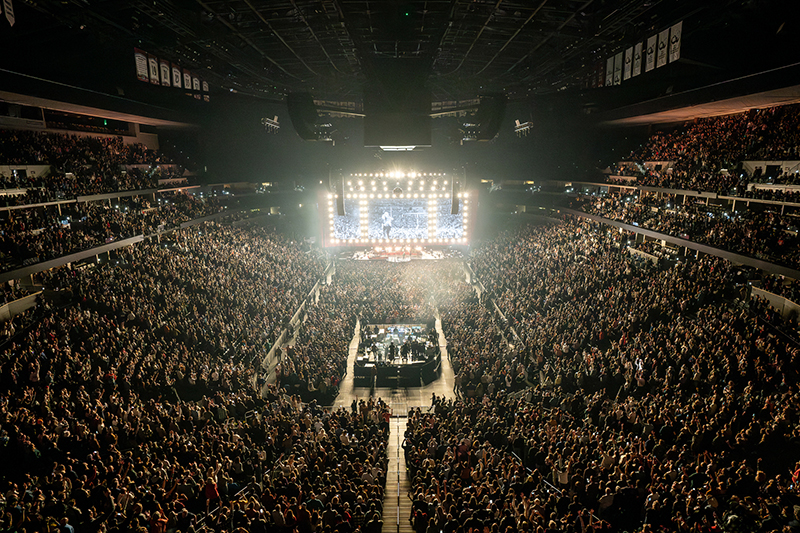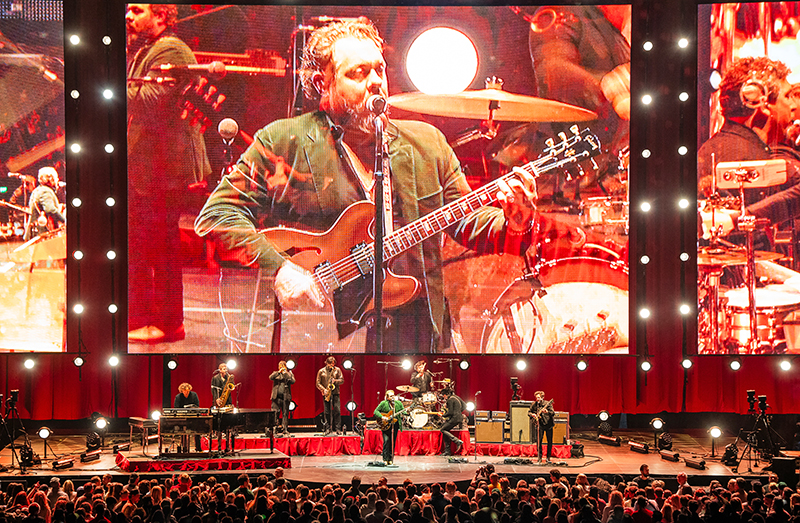
On December 15, Denver-based rock and soul band, Nathaniel Rateliff & The Night Sweats were back for their 19th annual holiday show, which for the last two years, played at Denver’s Ball Arena. In addition to celebrating a decade of the band’s music, the holiday show also raised money for local organizations that Rateliff and the band support. This year, money was raised for the Harm Reduction Action Center and EarthLinks, two Denver organizations Rateliff and his Marigold Project are passionate about. Brown Note Productions, a longtime supporter of the band’s production needs, provided lighting, video, rigging, and audio for the show.
Production Designer Jeremy Roth and Video Designer / Director Michael John Grant were part of the creative team for the holiday show, which built on the band’s tour design, notably adding video, a production element they normally don’t tour with. Both designers took time, along with Sara Knutson, CEO and Account Executive of Brown Note, to talk about scaling up the design for the arena-sized philanthropic production, the solutions they brought to solve production challenges, and about Brown Notes support for the production team.
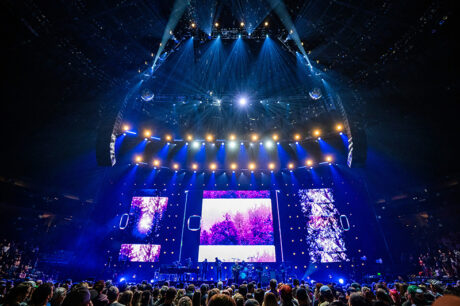
JEREMY ROTH
Production & Lighting Designer
Jeremy Roth has been working with the band since 2017. He speaks to the old school lighting he likes to bring to highlight Nathaniel Rateliff & The Night Sweats. “These guys have been doing holiday shows even before I started working with them,” says Roth. “As they’ve grown, the audience has grown and since they’re a Denver band it went from a night at say, the Ogden Theater, a relatively small venue a couple of years ago, to multiple nights at the Mission Ballroom, and then last year they moved up to an arena. This is the second year at Ball Arena.”
There were some important design aspects that Roth wanted to bring to support the band. “The Night Sweats band is like a retro-soul throwback, so my approach with them has always been to bring in lighting from that period, which is mostly just tungsten, incandescent elements, to support the old-school style that they’re playing in. For the past couple years, I’ve been just going through all the various available tungsten light fixtures; lately we’ve been leaning pretty heavily into the CHAUVET Strike 1s. The number of them grows every time we do a show. For this year’s show, there were 133 of them! I used them as a frame for the three upstage video screens, and then used them also to line all the additional trusses, to give me lots of firepower when I needed it to light up the whole arena. But for the most part, those lights are just glowing, more of a scenic element than actually a practical light in that situation. They’re usually running no more than five to 10%, but then when I need them and I bring them up to 100%, it’s very, very bright—and very effective for those moments.”
Key Gear Choices
For some of his other fixture choices, Roth explains some of his thinking behind his picks. “I use X4 Bars on the deck as a low sidelight,” the designer explains. “They give me the look I need for not only the camera shots, but also for getting light on the band without having it be too high and sort of washy. In my approach to design, I generally pick fixtures that are going give me as many options as possible to create varied looks, but I’m not really into a lot of the advances in lighting technology. The more manufacturers can make a light for me that dims really nicely and has great color saturation. Those are the things I actually care about. The bells and whistles are spinning around circles endlessly, I don’t use any of that particularly on this show.”
Roth’s design is “pretty restrained. There is movement throughout the show, but I’d say at least half of the show the lights are in static focuses,” says the designer. “There’re big moments where there’s ballyhoos, but a lot of it is really about bringing it down to the stage level and the performers and not creating a distraction with the lighting. That said, I will say that one fixture that I’ve been using a lot over the past couple of years is the Robe Spiider. I love that. It’s a fabulous wash light. It’s got great color saturation and great layering. I also use a lot of pastels and about 10 different varieties of amber. So, I’m always looking for a light that can achieve lots of unsaturated colors without it tending to look green or weird in some way. So, it gets me all of that, and then having that Spiider flower effect, which essentially turns it into a single gobo profile fixture for points in the show where all of a sudden, I’m looking to do something different. It’s pretty invaluable. I’ve even had them on other shows where there were almost no profile fixtures, and I was able to just use a lot of wash fixtures and then occasionally use that gobo look as needed.”
For followspots, Roth is using the Robe RoboSpots paired with Robe iFORTES. “We tried out a number of different automated spot systems throughout the years and really landed on the RoboSpot as being the most solid,” he comments. And truthfully, it’s like I never, ever, ever want to hear from an artist—either before, during, or after a show—’Hey, what the hell is going on with the spotlights?’ The number of times that I’ve heard that throughout my career! They shouldn’t be thinking about the lighting at all, ever, except for when I show them pictures later. So, the RoboSpot was a great way for us to be able to get the angles we wanted, all of the cueing as to when it comes on and when it goes off, and what color it’s in is all from the desk. Since we implemented that system, I have yet to hear anything about it, which is exactly what I want.”
Changing up the Color
With Roth’s lighting design, he likes to play with the color temperatures with his lights, mainly staying in the warmer, tungsten area of the spectrum. Some of his color choices were influenced by one of his Lighting Directors, Michael J. Grant—the Video Designer/Director for the holiday show. “I’ve been the Production Designer for Nathaniel Rateliff & The Night Sweats since 2017 when I started working with them,” explains Roth, “but very rarely have I been on tour as a Touring Lighting Director as I also design for Wilco and Ray LaMontagne. At one point I reached out to Mike Grant, who is the Video Director on this show. He is also an incredible Lighting Designer; he’s been with the Black Keys since they were touring around in vans. We just lucked out that we were able to get him on board as the LD for Nathaniel Rateliff. Mike reprogrammed the show from where it had been previously. When I took back his show to pass it on to a different touring LD a couple of years ago, he shifted out of a lot of the more saturated colors that were in the show and had taken an approach, which I found really refreshing, which was mostly just using warm ambers and different varying levels of white and light blues CTBs. Removing a lot of the more garish colors from the show if you will. There are no magentas, no greens—not that there was a lot of that in the first place, but he pushed it even further into an unsaturated direction which, when I took the show back over to reprogram it for the next round of touring a couple years ago, I just stuck with what he had and leaned into it even further.”
Roth’s lighting does lot of shifting between warm and cool tones throughout a song, and then occasionally “I’ll take a deep dive into a saturated color, which then just makes it all that more powerful,” he continues. “There’s this moment, that I want to credit Mike for in one of their songs where it’s one of the few times in the show where we go from any color into just deep red with some movements in a tight zoom in white. It’s a moment musically that really calls for a big shift. They go from one part of the tune into this really almost angry section where the horn section just becomes prominent; it’s a really cool moment in the show. Every time it happens, everybody in the crowd just goes crazy. And it’s one of those moments in the show where you know. You can clearly see from the reaction every night that what’s happening between the lighting and the music is so well put together that it elicits a reaction from the crowd almost every time.”
Scalable Design
Rateliff and the band are on the road touring a good part of each year. Roth will keep a design for an entire record cycle and adapt as needed. For instance, if they tour Europe, the design needs to be scaled down. Each year, they do two sets of feature shows for the Denver area—two nights at Red Rocks, and this holiday show. “They’ve played Red Rocks for the past five or six years,” says Roth,” two nights at Red Rocks as their big summer shows, and then this holiday show. So oftentimes the show that we’re touring can be put into Red Rocks but at the scale of the amphitheater, and the angle at which the seating is set, it doesn’t always work and have it look as good as it can be. We’ve gotten into the habit of scaling up for Red Rocks, and now that we’re doing Ball Arena as the holiday show, we’re also doing the same thing. This year we took the touring overhead rig and put it into Red Rocks and then redesigned the entire upstage section of it to include the three video screens and the [CHAUVET] STRIKE 1 surrounds and made some modifications to the deck package. So, we took the Red Rock Show and put it into Ball Arena as the initial pass on design, and then looking at that in arena in WYSIWYG, realizing that it needed to be scaled up even further than that. Red Rocks is pretty big, but then when you drop it into a basketball arena, it doesn’t look quite as big. We just scaled it up even further. We essentially just took everything and screen sizes and lighting truss sizes and scaled it up by 15% to fill from vom to vom, side to side in the arena.”
Brown Note Productions has been supplying production equipment and solutions to Nathaniel Rateliff & The Night Sweats since their beginnings. Roth appreciates their unwavering support for the band and his designs. “Sara Knutson is our Account Executive, and she’s the CEO of the company,” comments Roth. “So, it works out really well having the CEO as your Account Rep! Anytime we want to add new fixtures, it’s not a problem. She’s been buying more. Every time we’d go out with a show over the past couple years, she has had to buy more STRIKE 1s for us, which is not a problem. Brown Note has been great, and the past couple of years’ worth of techs have been spot on; amazing. Their gear is in great condition. They support the whole show—audio, video, and lighting. I love being able to go to one shop for everything. It makes it easier on everything. I mean, their support’s been phenomenal all across the board, from the L3 all the way up to the CEO.”
Production Support
Roth also wants to call out Production Manager, David Gleason for his support of Roth and the creative and technical teams for the tours and featured shows. “David Gleason, he’s great. He’s been with the band since the beginning,” says Roth, “And without him and his support, we couldn’t do these shows. Every time we do one of these big shows, we know that the more we do these, the better we get at it. Even though the shows are getting harder and more challenging and complicated, because we have such a good working relationship and friendship, it just makes it easy. I know he has got my back. Truthfully, that’s true across the entire board with this band, and all of the people like Tour Manager Will Pepple, upper management, even the backline guys. Will is incredibly supportive of everything that I need to do in order to make these shows happen. Everybody on the crew understands that lighting and production are a big part of what this show is, and people are happy to be accommodating and be supportive in order for us to be able to do that.”
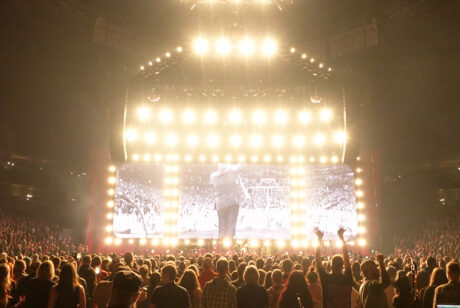
MICHAEL JOHN GRANT
Video Designer / Director
Michael John Grant has been working with Nathaniel Rateliff & The Night Sweats since 2017 as well. He normally doesn’t tour with the band as they normally take a much smaller video package, only expanding for the featured shows at Red Rocks and Ball Arena. He speaks about layering his video in with Roths’ production and lighting design work. “Jeremy and I work really well together,” he says. “I’m mostly a lighting guy, I’ve done video a few times, but he’s very open to ideas and just kind of letting things flow, which is nice. There’s not a lot of stringent, ‘This needs to be this, this needs to be this,’ just as long as it looks good. That’s kind of the MO. I was the Lighting Director for NRNS, but my main act is the Black Keys, which I’ve been with since 2008. When the Keys went back on tour, I had to relinquish the Nathaniel job.”
Added Dimension
When NRNS played their summer featured shows at Red Rocks, Roth and Grant chose to use the ROE Visual’s Vanish V8T LED video panels so the backstage rocks of the amphitheater could show through the video panels. At Ball Arena, the creative team went with a red velour drape behind the blow-through LED screens for added depth and visual interest. “We wanted to light the rocks a bit to have them coming through the screens at Red Rocks,” explains Grant. “At Ball Arena, we had a nice, red backdrop behind it to get some nice three-dimensional looks with it, so going with blow-through panels was the way to go. We also scaled up the size of the video screens. Obviously, the roof at Red Rocks is much lower than what you can do in something like Ball Arena, so it was just bringing it up in scale to make it what it should be. The main difference between the touring rig and the feature shows like Ball Arena is strictly video. There’s no video on the touring rig at the moment, so adding the video element really adds a little punch to the featured shows, I think. Red Rocks is about 9,000 seats and Ball is about twice as big, close to 20,000 for a concert.”
Much of the video throughout the show is used for I-Mag, with Grant saying, “it’s 60/40 I-Mag to content. The content’s created by myself, Jeremy, and a gentleman named Richard Swift who used to produce Nathaniel’s records. He passed away a few years ago, but we still get to use some of his content, which is nice.” When it comes to content to underscore the band and their performance, Grant says, “I’ll find pieces that reflect a song nicely, and not overpower by any means, as it’s supposed to just be a backdrop and enhance what’s happening on the stage. I never really want the content—or the I-Mag—to be the main focal point. The band is the main focal point; everything else is just supposed to enhance it. In terms of color, sometimes I’ll go off what Jeremy’s putting out, but if there’s a special piece of content I like, I’ll ask him to change his colors. There were a couple of songs, where I wondered if he’d be against changing his colors to match my content and it was no problem. Whatever makes it look good, we’re going to do that. A lot of times I interlace content with I-Mag. I like the effects that brings out more than a lot of media server effects. I use some blur effects, and definitely some black and white effects, but nothing crazy like Notch or anything like that.”
Image Control
Grant chooses to work with ArKaos MediaMaster media servers, that were supplied by Bigtime Lighting Design, a partner with Grant on other projects. “The MediaMaster has eight camera inputs, so everything runs into the media server and straight on to the screens,” explains Grant. In terms of control of the video system, Grant relies on his lighting background and uses a console. “I program everything through a grandMA3 console using MA2 software. I programmed the whole show all cue to cue, like you would a normal lighting show, but with cameras instead. I have six robo cams on stage with two different operators, and then two long lens cameras at front of house, with a single operator.”
The rest of the video equipment—LED video panels, consoles, etc. was all provided by Brown Note Productions, along with Roth’s lighting package. Grant comments that Brown Note’s support for him and the video products for the Ball Arena show was, “Wonderful. They’re always great and easy to work with. If we ask for something, they are on it immediately. I have no complaints whatsoever.”
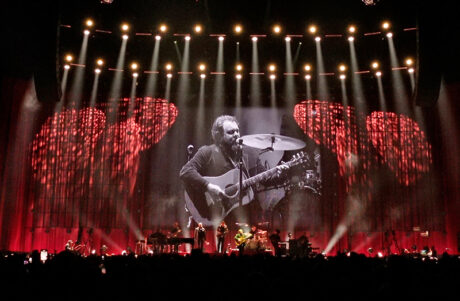
VENDOR VIEW
Sara Knutson, CEO and Account Manager, Brown Note Productions
On working with Production and Lighting Designer Jeremy Roth:
We are consistently blown away by Jeremy’s creativity and attention to detail. Jeremy brings a unique artistic perspective to the production and always considers every aspect of the visual experience. He possesses a deep technical understanding and his capacity for collaboration makes him easy and enjoyable to work with.
On supporting Video Designer/Director Michael Grant:
Michael has a notable creative flair that makes working with him on a show really rewarding. Michael is a skilled video designer and brings a wealth of creative vision and technical expertise to the table. His understanding of visual storytelling and his unique approach to video design really set the production apart. He is versatile, detail oriented, and innovative in his approach to design.
On working with Production Manager David Gleeson:
It has been a pleasure to work with David Gleeson on Nathaniel Rateliff’s tours and one-offs for many years. We have the shared goal of bringing the production to life and ensuring that the show goes off seamlessly. Davy’s clear communication is extremely helpful in understanding specific equipment requirements and assists in our ability as the vendor to provide our highest level of support. His meticulous planning and technical understanding ensure the show goes off without a hitch.
On why Brown Note was the right vendor:
We have built a strong and longstanding client relationship based on mutual trust and collaboration over the years. We worked closely with Jeremy Roth, Michael Grant, and David Gleeson to create a comprehensive plan for lighting and video solutions. With our rider-friendly inventory and experienced and skilled personnel along with our thorough approach to prep, we were able to bring their vision to life and create a stunning, impactful show.
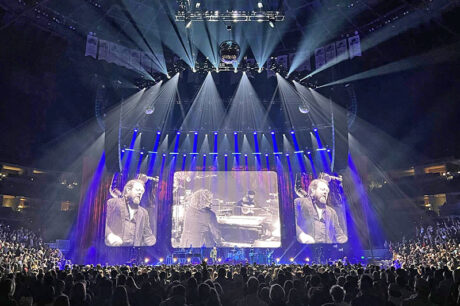
PRODUCTION TEAM
- Tour Manager: William Pepple
- Production Manager: David Gleeson
- Production and Lighting Designer: Jeremy Roth
- Video Designer / Video Director: Michael J. Grant
- Lighting Directors: Jeremy Roth & Adam Waguespack
- Lighting Production Manager: David Van Name
- Lighting System Techs: Andrew Brown, Adam Miehe
- Lighting Dimmer Techs: Conner Bass, Matt Dury
- Lighting Stage Techs: Nick Vidmar, Marco Valadez, Ryan Kaniski,
Brady Coates, Cameron Bullard, Christopher Tester - Video System Engineers: Brian Weyrich, Rowan Moore
- Video Lead LED Tech: Matt Ardoin
- Video LED Techs: Hunter McKinnon, Celine Studer, Stephen Moodie, Sterling Zill, Rory Taylor

VENDOR
Brown Note Productions, Inc.
Account Managers: Sara Knutson, Ryan Knutson
GEAR
Lighting
- 33 Robe iFORTE
- 21 Robe MegaPointe
- 33 Robe Spiider
- 29 Ayrton Perseo Profile S
- 33 GLP impression X4 Bar 20
- 133 CHAUVET STRIKE 1 LED Blinder
- 4 Robe RoboSpot MotionCamera
- 4 MDG theONE Atmospheric Generator
- 1 grandMA3 full-size Console
Video
- 225 ROE Visual Vanish V8T LED Video Panel
- 1 Ross Carbonite Flypack
- 6 Panasonic AW-UE150KPJ 4K-HD 20x PTZ Camera Kit
- 1 Panasonic AW-UE150K 4K-HD 20x PTZ Camera
- 2 Panasonic AW-RP150GJ Remote Camera Controller Kit
- 2 Panasonic AK-UC3000GSJ 4K HDR Studio Camera Kit
- 1 grandMA 3 full-size Console
- 1 ArKaos MediaMaster Media Server
